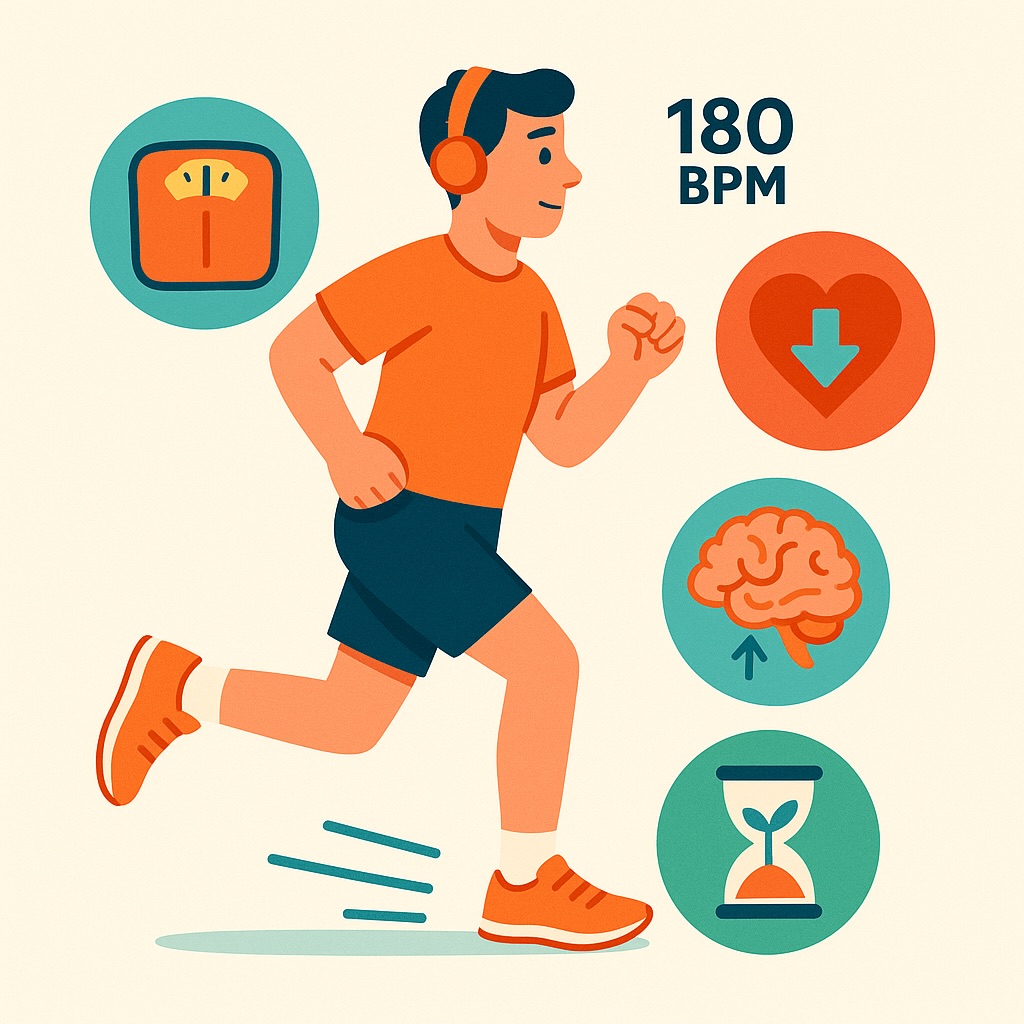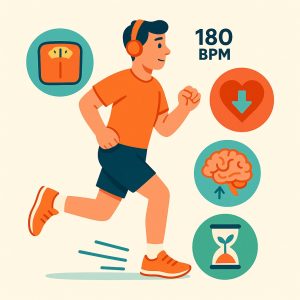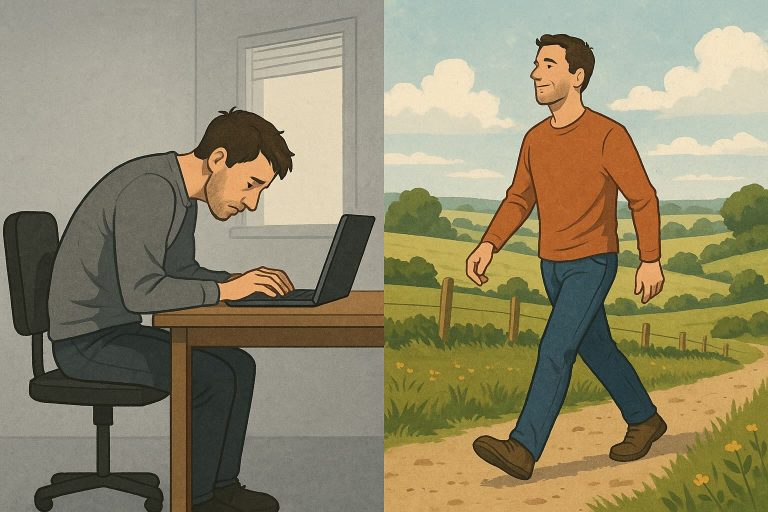“Run with a smile, land like a cat, and keep the beat at 180.” — Prof. Hiroaki Tanaka
After trying Tanaka’s “slow‑jog shuffle” for only four days, my scale slid from 95 kg to 94 kg, and I finished each session surprisingly energized. Those quick wins convinced me this rhythm‑based style deserves a closer look.
Ever wished you could keep the perks of running without the sore knees and huff‑and‑puff soundtrack? Slow jogging might be your golden ticket. Developed by Japanese exercise physiologist Prof. Hiroaki Tanaka, this technique trades speed for rhythm: 180 BPM beats per minute—also called cadence—of tiny, spring‑loaded steps that feel closer to brisk walking than to a 5 K race. Yet, research shows those small steps deliver outsized health dividends: lower blood pressure, sharper thinking, even a few bonus years of life.

Why 180 BPM Slow Jogging Heals the Body
| Benefit | Why It Works | Quick Evidence |
|---|---|---|
| Gentle Cardio Load | Running below the lactate threshold keeps effort “easy” while doubling calorie burn compared to walking | Tanaka & Jackowska 2019[#1] |
| Blood Pressure Drop | Regular aerobic slow jogging lowers resting SBP/DBP by ~5/3 mm Hg | Cornelissen V.A., Smart N.A. (2013) [#2] |
| Brain Boosting Blood Flow | 10‑min slow run increases bilateral prefrontal‑cortex activation, improving executive function | Scientific Reports 2021 study[#3] |
| Longevity Bump | 1–2.5 h of slow/average jogging per week is linked to ~5 years longer life | Copenhagen City Heart Study 2015[#4] |
Good to know: Because cadence stays high while stride length stays short, ground‑reaction forces are lower than in regular jogging—your joints will thank you.
Gear Checklist
- Thin, Flexible Shoes
Think minimalist racers or barefoot‑style trainers. Thick midsoles dull ground feel and invite heavy heel strikes. - Cadence Metronome
Set a metronome app to 180 BPM, or pick songs near that tempo (for instance, “Country Trainbeat 8ths | Drum Metronome Loop | 180 BPM” ). - Comfort‑First Clothing
Lightweight layers let you “jog with a smile,” Tanaka’s favourite cue. - Safe Surface
A rubberised track, treadmill, or smooth carpet is ideal while foot muscles adapt.
Mastering the 180 BPM Technique
1. Short, Triple‑Tempo Strides
Count “1‑2‑3 / 1‑2‑3” in your head. Each foot lands almost directly beneath your body, not way out in front. Your stride length will feel roughly half of your normal jog.
2. Mid‑Foot—or Ball‑of‑Foot—Landing
Touch down softly on the mid‑foot, gradually extending your mid‑foot time so calves and Achilles can adapt without strain. The heel may kiss the ground an instant later, but never lead. This lowers impact shock and guards the knees.
3. Upright Posture
- Maintain an upright posture, gaze 10–15 m ahead (or at eye‑level if you’re indoors).
- Shoulders relaxed, chest “proud.”
- Minimal vertical bounce—think glide, don’t hop.
4. Cadence Over Speed
Speed comes from stride length. If you get breathless, keep 180 BPM and simply shorten your steps.
At‑Home Slow Jogging Progression
No treadmill? No problem.
A 2 × 3 m clear patch of floor is enough—the cadence, not the distance, drives the health gains.
Warm‑Up (4 min)
- March in place 1 min
- Dynamic leg swings, arm circles 3 min
Beginner Session (18 min)
| Segment | Duration | What to Do |
|---|---|---|
| Round 1 | 3 min | Jog in place at 180 BPM; focus on soft mid‑foot landings |
| Walk Break | 1 min | Shake out calves, reset posture |
| Round 2 | 3 min | Jog small diagonals across the room |
| Walk Break | 1 min | Deep breaths, shoulders loose |
| Round 3 | 3 min | Mini‑laps around furniture—still 180 BPM |
Cool‑Down (3 min)
- Easy walking in place or slow laps
- Gentle calf, hip, and hamstring stretches
- Week 1 – 2: Alternate 30‑sec jog / 30‑sec walk for 10 min.
- Week 3 – 4: Continuous 10‑min jog in place.
- Week 5 +: Graduate to 20‑min sessions or outdoor shuffle runs.
Tips for Long‑Term Success
- Start Slowly: Honour the adaptation curve; foot muscles need time in thin shoes.
- Focus on Cadence: Use the metronome until 180 BPM feels automatic.
- Listen to Your Body: Discomfort = form check; sharp pain = rest and review.
- Mix Surfaces: Grass, track, and carpet each stress tissues differently—variety prevents overuse.
- Self‑Film Your Form: Position a tripod or request a friend to capture 30 seconds of your shuffle. During playback, ensure that each foot makes contact gently on the mid-foot directly beneath your center of mass (avoiding heel or toe strikes) and that your head-to-heel alignment remains upright; video feedback identifies form discrepancies more quickly than relying solely on sensation.
- Enjoy the Process: Put on your favourite high‑tempo tunes and smile (it actually lowers perceived effort).
Key Precautions
- Medical Clearance: If you have uncontrolled hypertension, diabetes, or cardiac issues, consult your doctor first.
- Build Volume Gradually: Add no more than 10 % weekly to total jogging time.
- Surface Awareness: Slick tiles or uneven ground spike injury risk—stick to grippy floors.
- Footwear Transition: Going minimalist overnight can strain calves and Achilles; allow 4–6 weeks.
- Pain Signals: Persistent heel, forefoot, or Achilles pain means stop, ice, and reassess technique.
Frequently Asked Questions
Do I need exactly 180 BPM?
No—but close helps. Most adults find ground‑reaction forces drop sharply between 170 and 190 steps/min. Taller runners may sit near 170; shorter folks near 190. Prioritise soft landings over hitting the perfect number.
Can I slow jog on the spot all winter?
Absolutely. Jog‑in‑place keeps cadence cues alive, maintains foot‑strength gains, and fits between Zoom calls. Just avoid stomping (your downstairs neighbour will thank you).
Do I still need long runs for endurance?
If your goals are health, weight management, or recovery, 20‑ to 30‑minute slow‑jog sessions are plenty. Competitive distance runners can use slow jogging as active recovery between hard workouts.
Reference Resources
- Tanaka H., Jackowska M. (2019). Slow Jogging: Step by Step to Healthy Fitness. PDF
- Cornelissen V.A., Smart N.A. (2013) “Exercise Training for Blood Pressure: A Systematic Review and Meta‑Analysis.“
- Chorphaka Damrongthai(2021) “Benefit of human moderate running boosting mood and executive function coinciding with bilateral prefrontal activation“
- Schnohr P. et al., “Dose of Jogging and Long-Term Mortality: The Copenhagen City Heart Study,”
- YouTube: Master 180 Steps‑Per‑Minute Cadence — https://www.youtube.com/watch?v=9L2b2khySLE
- Slow Jogging—Running Metronome App (Android / iOS)
Final Thought
Swap the grinding miles for a rhythm that feels like flying in slow motion. Lace up those thin shoes, cue a 180‑BPM beat, and shuffle your way to better blood pressure, brighter brainpower, and maybe even a longer life span. Healing can be just three tiny steps away—taken 180 times a minute.




